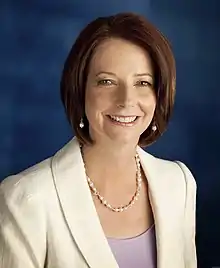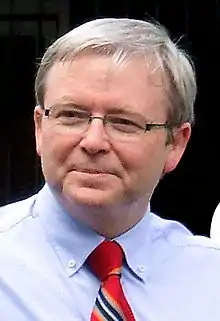Anthony Albanese
Anthony Norman Albanese ( /ˌælbəˈniːzi/ AL-bə-neez-ee or /ˈælbəniːz/ AL-bə-neez;[nb 1] born 2 March 1963) is an Australian politician serving as Leader of the Opposition and leader of the Australian Labor Party (ALP) since 2019. He has been Member of Parliament (MP) for Grayndler since 1996. Albanese was Deputy Prime Minister of Australia in 2013 and a Cabinet Minister in the Rudd and Gillard Governments from 2007 to 2013.
Anthony Albanese | |
|---|---|
.jpg.webp) Albanese in October 2020 | |
| Leader of the Opposition | |
| Assumed office 30 May 2019 | |
| Prime Minister | Scott Morrison |
| Deputy | Richard Marles |
| Preceded by | Bill Shorten |
| Leader of the Labor Party | |
| Assumed office 30 May 2019 | |
| Deputy | Richard Marles |
| Preceded by | Bill Shorten |
| Deputy Prime Minister of Australia | |
| In office 27 June 2013 – 18 September 2013 | |
| Prime Minister | Kevin Rudd |
| Preceded by | Wayne Swan |
| Succeeded by | Warren Truss |
| Deputy Leader of the Labor Party | |
| In office 26 June 2013 – 13 October 2013 | |
| Leader | Kevin Rudd |
| Preceded by | Wayne Swan |
| Succeeded by | Tanya Plibersek |
| Minister for Infrastructure and Transport | |
| In office 3 December 2007 – 18 September 2013 | |
| Prime Minister | Kevin Rudd Julia Gillard |
| Preceded by | Mark Vaile |
| Succeeded by | Warren Truss |
| Leader of the House of Representatives | |
| In office 3 December 2007 – 18 September 2013 | |
| Prime Minister | Kevin Rudd Julia Gillard |
| Deputy | Stephen Smith |
| Preceded by | Tony Abbott |
| Succeeded by | Christopher Pyne |
| Minister for Regional Development and Local Government | |
| In office 3 December 2007 – 28 June 2010 | |
| Prime Minister | Kevin Rudd Julia Gillard |
| Preceded by | Jim Lloyd |
| Succeeded by | Simon Crean |
| Shadow Minister for Infrastructure, Transport and Regional Development | |
| In office 18 October 2013 – 30 May 2019 | |
| Leader | Bill Shorten |
| Preceded by | Warren Truss |
| Succeeded by | Catherine King |
| Manager of Opposition Business | |
| In office 10 December 2006 – 3 December 2007 | |
| Leader | Kevin Rudd |
| Preceded by | Julia Gillard |
| Succeeded by | Joe Hockey |
| Member of Parliament for Grayndler | |
| Assumed office 2 March 1996 | |
| Preceded by | Jeannette McHugh |
| Personal details | |
| Born | Anthony Norman Albanese 2 March 1963 Camperdown, New South Wales, Australia |
| Political party | Labor |
| Spouse(s) | |
| Children | 1 |
| Alma mater | University of Sydney |
| Website | Official website |
| Nickname(s) | Albo |
Albanese was born in Sydney and attended St Mary's Cathedral College, before going on to the University of Sydney to study economics. He joined the Labor Party as a student, and before entering parliament worked as a party official and research officer. Albanese was elected to the House of Representatives at the 1996 election, winning the Division of Grayndler in New South Wales. He was first appointed to the Shadow Cabinet in 2001 and went on to serve in a number of roles, eventually becoming Manager of Opposition Business in 2006.
After Labor's victory in the 2007 election, Albanese was appointed Leader of the House; he was also made Minister for Regional Development and Local Government and Minister for Infrastructure and Transport. In the subsequent leadership tensions between Kevin Rudd and Julia Gillard from 2010 to 2013, Albanese was publicly critical of the conduct of both, calling for unity. After the final leadership ballot between the two in June 2013, Albanese was elected Deputy Leader of the Labor Party and was sworn in as Deputy Prime Minister of Australia the following day.
Following Labor's defeat in the 2013 election, Albanese stood against Bill Shorten in the ensuing leadership election, the first to include party members as well as MPs. Although Albanese won a large majority of the membership, Shorten won more heavily among Labor MPs; Shorten subsequently appointed Albanese to his Shadow Cabinet. After Labor's third consecutive defeat in the 2019 election, Shorten resigned. Albanese became the only person to nominate in the leadership election; he was subsequently declared elected unopposed as the Leader of the Labor Party, becoming Leader of the Opposition.[3][4]
Early life
Albanese was born in the inner-Sydney suburb of Camperdown, the son of Carlo Albanese and Maryanne Ellery. His mother was of Irish descent, while his father was from Barletta, Italy. His parents met on a cruise ship, but did not continue their relationship afterwards, going their separate ways.[5][6] Growing up, Albanese was told that his father had died in a car accident; he did not meet his father, who was in fact still alive, until 2009, tracking him down with the assistance of the Australian Embassy in Italy. He subsequently discovered that he had two half-siblings.[5][6]
Education
Albanese was educated at St Joseph's Primary School in Camperdown and St Mary's Cathedral College in Sydney.[7] His mother Maryanne raised him by herself in public housing, and Albanese would later say that she had raised him with "three great faiths: the Catholic Church, the South Sydney Football Club and Labor", adding that he had always remained faithful to the latter two.[8]
After finishing school, he worked for the Commonwealth Bank for two years before studying economics at the University of Sydney.[9] There he became involved in student politics and was elected to the Students' Representative Council.[10] It was also there where he started his rise as a key player in the left faction of the Labor Party.[11] During his time in student politics, Albanese led a group within Young Labor that was aligned with the left faction's Hard Left, which maintained "links with broader left-wing groups, such as the Communist Party of Australia, People for Nuclear Disarmament and the African National Congress".[12]
Pre-parliamentary career
After completing his economics degree, Albanese took on a role as research officer to the then-Minister for Local Government and Administrative Services, Tom Uren, who would become a mentor to him.[13] In 1989, the position of Assistant General Secretary of the New South Wales branch of the Labor Party became vacant when John Faulkner was elected to the Senate. The election to replace him was closely disputed between the Labor Left's Hard Left and Soft Left groupings, with Albanese being elected with the backing of the Hard Left, taking on that role for the next six years.[12] In 1995, he left the position to work as a senior adviser to New South Wales Premier Bob Carr.[9]
Early political career
Entry to Parliament
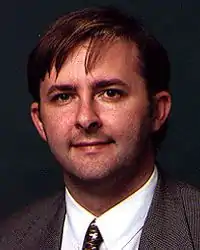
When Jeannette McHugh announced she would not recontest her seat of Grayndler at the 1996 election, Albanese won preselection for the seat. The campaign was a difficult one, with aircraft noise a big political issue following the opening of the third runway at Sydney Airport, and the newly established No Aircraft Noise party (NAN) having polled strongly in the local area at the 1995 New South Wales election. Veteran political pundit Malcolm Mackerras predicted NAN would win the seat. However, NAN's candidate finished third, with less than 14% of the vote. Despite suffering a six-point swing against Labor, Albanese was elected with a comfortable 16-point margin.[14]
In his maiden speech to the House of Representatives, he spoke at length about aircraft noise and the need to build a second Sydney Airport, as well as his support for funding public infrastructure in general, multiculturalism, native title, the social wage and childcare. He concluded by saying, "For myself, I will be satisfied if I can be remembered as someone who will stand up for the interests of my electorate, for working-class people, for the labour movement, and for our progressive advancement as a nation into the next century."[14]
In his first year in Parliament he continued this theme, speaking up on behalf of the Northern Territory's euthanasia legislation, and entitlement to superannuation for same-sex couples.[15] indigenous people in the Hindmarsh Island bridge controversy[16][17] This latter issue became something of a crusade for Albanese. In 1998 he unsuccessfully moved a private member's bill that would have given same-sex couples the same rights to superannuation as de facto heterosexual couples.[18] Over the next nine years, he tried three more times without success, until the election of the Rudd Government in 2007 saw the legislation passed.[19] Albanese then turned his attention to campaigning for same-sex marriage.[20]
Appointment to Shadow Cabinet
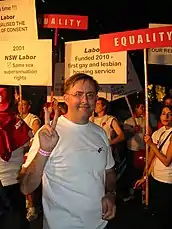
In 1998, Albanese was appointed a Parliamentary Secretary, a position which assists ministers and shadow ministers and is often a stepping stone to a full ministerial position.[21]
In 2001 he was promoted to the opposition Shadow Cabinet, taking the portfolio of Ageing and Seniors. A 2002 reshuffle saw him become Shadow Minister for Employment Services and Training, and in 2004 he became Shadow Minister for Environment and Heritage.[9] It was during this latter role that then-Prime Minister John Howard and Science Minister Brendan Nelson started raising the idea of nuclear power for Australia. Albanese campaigned strongly against them, as well as elements within his own party, arguing, "Nuclear energy doesn't add up economically, environmentally or socially, and after more than 50 years of debate, we still do not have an answer to nuclear proliferation or nuclear waste."[22][23]
In 2005, he was given the additional role of Shadow Minister for Water alongside his existing responsibilities, and was also appointed Deputy Manager of Opposition Business in the House. In December 2006, when Kevin Rudd first became Leader of the Labor Party, Albanese took over from Julia Gillard as Manager of Opposition Business in the House, a senior tactical role on the floor of the parliament, and was appointed Shadow Minister for Water and Infrastructure.[9]
Cabinet Minister
Rudd Government
Following Labor's victory at the 2007 election, Albanese's rise in standing within the party was evidenced by his appointment as Minister for Infrastructure and Transport, Minister for Regional Development and Local Government and Leader of the House of Representatives in the Rudd Ministry. Rudd was sworn in alongside his colleagues on 3 December 2007.
The Labor Party had gone to the election criticising the previous government for ignoring "long-term nation building in favour of short-term political spending".[24] One of Albanese's first moves as Minister for Infrastructure and Transport was the establishment of an independent statutory body, Infrastructure Australia, to advise the Government on infrastructure priorities. Armed with advice from this independent body and his own persuasive skills in the Cabinet, he was able to argue for a doubling of the roads budget and a tenfold increase in rail investment.[25] The establishment of Infrastructure Australia was regarded by many as a success; projects delivered through the Infrastructure Australia process included Melbourne's Regional Rail Link, the Hunter Expressway, the Ipswich Motorway, the Gold Coast light rail system G:link, the Redcliffe Peninsula railway line, the extension of the Noarlunga Centre railway line to Seaford, South Australia and various projects along the Pacific Highway in NSW and Bruce Highway in Queensland.[26]
Gillard Government
.jpg.webp)
After Julia Gillard replaced Kevin Rudd as Prime Minister in June 2010, she retained Albanese in his roles. Following the 2010 election which resulted in a hung parliament, Albanese was a key player in negotiating the support of independent members Tony Windsor and Rob Oakeshott through his role of Leader of the House. Albanese was also responsible for managing legislation through the House in the first hung parliament since the 1940s.[27]
In 2011, Albanese introduced two more major policy reforms. The first on urban planning drew on the work of Danish designer Jan Gehl and set out plans for urban design with better transport links and safety.[28] The second, on shipping, was notable for gaining the approval of both the conservative Australian Shipowners Associations and the radical Maritime Union of Australia.[29] However, he also attracted controversy when a convoy of trucks from North Queensland dubbed the "convoy of no confidence" descended on Canberra's Parliament House to protest against rising fuel costs and carbon pricing. During question time, Albanese labelled the protesters outside as "the convoy of no consequence". This caused outrage among supporters of the protest and a week later a public rally in support of the truckies was held outside Albanese's electorate office in Marrickville.[30]
Following a series of poor polls, leadership instability descended again on the Labor Government. Former Prime Minister Kevin Rudd resigned as Minister for Foreign Affairs in February 2012 to challenge Julia Gillard. Shortly before the ballot, Albanese came out in support of Rudd, stating that he had always been unhappy with the manner of Rudd's removal. He tearfully explained how he had offered his resignation as Leader of the House to the Prime Minister, but that she had refused to accept it, and called on Labor to cease leadership divisions and unify. In response to a question on his personal feelings around the leadership spill, he stated "I like fighting Tories. That's what I do."[31]
Deputy Prime Minister of Australia
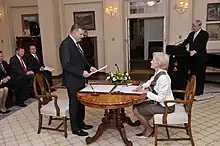
In June 2013, Rudd defeated Gillard in a final leadership election. That same ballot saw Albanese elected by the caucus as Deputy Leader of the Labor Party, and the following day Albanese was sworn in as Deputy Prime Minister.[32]
Return to Opposition
2013 leadership election
Following the defeat of Labor at the 2013 election, Albanese announced his candidacy to be Leader of the Labor Party, standing against Bill Shorten.[33] Shorten was announced as the winner after a month-long contest that was the first to involve a combined vote of MPs and rank-and-file members. Although Albanese won comfortably among party members, Shorten held a greater lead among MPs, and was duly elected.[34]
Shorten Opposition
In October 2013, shortly after the leadership election, Shorten appointed Albanese Shadow Minister for Infrastructure and Transport and Shadow Minister for Tourism; he would hold these roles throughout Shorten's time as leader.[35] In September 2014, Albanese was given the additional responsibility as the Shadow Minister for Cities.[36]
Leader of the Opposition
2019 leadership election
Bill Shorten announced his resignation as Leader of the Labor Party on 18 May 2019, following Labor's unexpected defeat in the 2019 election.[37][38] The day after, Albanese announced his candidacy in the subsequent leadership election.[39] On 21 May, Chris Bowen announced he would also contest the ballot; however, the next day, he announced his withdrawal, citing his lack of support among the party membership.[40] With no other candidate stepping forward, Albanese took the leadership unopposed on 30 May, with Richard Marles as his deputy.[41] Aged 56 when he took office, he is the oldest first-time Opposition Leader in 59 years, since Arthur Calwell (aged 63) took office in 1960.
Personal life
Albanese was married to Carmel Tebbutt,[42] former Deputy Premier of New South Wales and former member for the state electoral district of Marrickville, which until its abolition in 2015 overlapped with Grayndler in Sydney's Inner West. They have one son. Albanese and Tebbutt separated in 2019.[43]
Albanese describes himself as "half-Italian and half-Irish"[44] and a "non-practicising Catholic".[45] He is also a music fan who reportedly once went to a Pogues gig in a Pixies shirt[46] and intervened as Transport Minister to save a Dolly Parton tour from bureaucratic red tape.[47] In 2013, he co-hosted a pre-election special of music program Rage and his song selection included the Pixies and Pogues along with The Smiths, The Triffids, PJ Harvey, Hunters & Collectors and Joy Division.[48][49]
As a lifelong supporter of the South Sydney Rabbitohs, he was a board member of the club from 1999 to 2002 and influential in the fight to have the club readmitted to the National Rugby League competition.[50] During October 2009 The Sydney Morning Herald reported that Albanese had opposed an attempt to appoint the former Liberal Prime Minister John Howard to a senior position in the NRL. Albanese admitted he had phoned the NRL chief executive, David Gallop, as well as other league officials, to advise them against the idea. He then implored officials at Souths to help stop the suggestion from gaining momentum.[51] In 2013, he was made a life member of Souths.[50]
In June 2020, it was reported that Albanese was in a new relationship.[52] with Jodie Haydon.[53]
Albanese was injured in a side collision while driving in Marrickville, New South Wales, in January 2021. He underwent treatment at Royal Prince Alfred Hospital and was reportedly "injured externally and internally and had suffered considerable shock in the immediate aftermath of the impact". The other driver was a 17-year-old teen who received a ticket for negligent driving.[54] Emergency workers have told Albanese that if the teen's car had hit just 30 centimetres either side of where it did, Albanese "would almost certainly have been killed".[55]
See also
Notes
References
- Middleton, Karen (2016). Albanese: Telling It Straight. Random House Australia. p. 240.
- Webb, Tiger (30 May 2019). "Anthony Albanese can't decide how to pronounce his name, so don't ask him". ABC News. Retrieved 1 June 2019.
- Murphy, Katharine (19 May 2019). "Anthony Albanese kicks off Labor leadership race with call for policy shift". The Guardian. Retrieved 20 May 2019.
- Martin, Sarah (2 May 2019). "Anthony Albanese elected unopposed as Labor leader". The Guardian. Retrieved 27 May 2019.
- Anthony Albanese's long-held family secret, ABC News, 23 August 2016. Retrieved 20 October 2017.
- The long way back, The Australian, August 2016. Retrieved 20 October 2017.
- "Anthony Albanese". Australian Labor Party. Archived from the original on 5 February 2013. Retrieved 17 March 2013.
- "Transcript of Press Conference 25 Feb 2012". Anthony Albanese personal website. Retrieved 17 March 2013.
- "The Hon Anthony Albanese MP". Parliament of Australia. Retrieved 17 March 2013.
- "Rise of the campus pollies". The Age. Retrieved 17 March 2013.
- "Crikey List: which MPs were involved in student politics?". Crikey. Retrieved 17 March 2013.
- Leigh, Andrew (2000). "Factions and Fractions: A Case Study of Power Politics in the Australian Labor Party" (PDF). Australian Journal of Political Science. 35 (3): 427–448. doi:10.1080/713649348. S2CID 144601220.
- "Anthony Albanese". The Power Index. Archived from the original on 19 April 2013. Retrieved 17 March 2013.
- "Governor-General's Speech: Address-in-Reply: Maiden Speech". Parliament of Australia. Retrieved 17 March 2013.
- Albanese, Anthony MP (28 October 1996). "Euthanasia Laws Bill 1996". Australian House of Representatives: Hansard. Commonwealth of Australia. Retrieved 29 March 2013.
- Albanese, Anthony MP (6 November 1996). "Hindmarsh Island bridge Bill 1996". Australian House of Representatives: Hansard. Commonwealth of Australia. Retrieved 29 March 2013.
- Albanese, Anthony MP (10 December 1996). "Superannuation: Same sex partners – Adjournment debate". Australian House of Representatives: Hansard. Commonwealth of Australia. Retrieved 29 March 2013.
- Albanese, Anthony MP (22 June 1998). "Superannuation (Entitlements of same sex couple) Bill 1999". Australian House of Representatives: Hansard. Commonwealth of Australia. Retrieved 29 March 2013.
- Albanese, Anthony MP (24 August 2011). "Same-Sex Relationships – Constituency statements". Australian House of Representatives: Hansard. Commonwealth of Australia. Retrieved 29 March 2013.
- "Full list of changes to the Gillard ministry". The National Times. 22 November 2010. Retrieved 29 March 2013.
- Albanese, Anthony MP (6 September 2012). "House of Representatives Practice". Commonwealth of Australia. pp. 70–71. Retrieved 27 April 2013.
- "An abrogation of responsibility". Online Opinion. 9 May 2006. Retrieved 27 April 2013.
- "Howard welcomes new debate on nuclear power". The Age. 10 June 2005. Retrieved 27 April 2013.
- Albanese, Anthony MP (19 December 2008). "Transcript of Joint Press Conference with Sir Rod Eddington, Chair of Infrastructure Australia". Department of Infrastructure and Transport. Archived from the original on 15 May 2013. Retrieved 26 August 2013.
- Albanese, Anthony MP (28 June 2011c). "Governing for the Long Term National Interest". Department of Infrastructure and Transport. Archived from the original on 14 May 2013. Retrieved 26 August 2013.
- Ludlow, Mark (11 May 2011). "Pacific Highway upgrade big winner". Australian Financial Review. p. 15.
- Coorey, Phillip (9 December 2010). "Power Society – Politics". Sydney Morning Herald. p. 44.
- Murphy, Jason (1 December 2011). "Canberra sets agenda". Australian Financial Review. p. 50.
- Gerritsen, Natalie (5 May 2011). "Shipping reforms head in right direction". Australian Financial Review. p. 2.
- McDonald, Timothy (9 January 2011). "Albanese faces off against anti-carbon tax protesters". ABC Online. Retrieved 18 July 2013.
- Albanese, Anthony (25 February 2012). Labor Minister Anthony Albanese sheds tears as he supports Kevin Rudd. Australia News Network. Canberra, Australia. Retrieved 4 March 2013.
- Packham, Ben; Shanahan, Dennis (26 June 2013). "Gillard backers quit as Labor MPs return to Rudd to take on Abbott". The Australian. Retrieved 26 June 2013.
- Cullen, Simon (13 September 2013). "Anthony Albanese to run for Labor leadership against Bill Shorten". ABC News. Australia. Retrieved 15 October 2013.
- Griffiths, Emma (13 October 2013). "Bill Shorten elected Labor leader over Anthony Albanese after month-long campaign". ABC News. Australia. Retrieved 15 October 2013.
- Henderson, Anna (18 October 2013). "Bill Shorten announces shadow ministry portfolios, Tanya Plibersek handed foreign affairs". ABC News. Retrieved 14 October 2015.
- Massola, James (24 September 2014). "Labor to tackle 'drive-in-drive-out suburbs as Anthony Albanese appointed party's cities spokesman". The Sydney Morning Herald. Fairfax Media. Retrieved 14 October 2015.
- "Labor's Shorten concedes Australia election". BBC News. Retrieved 18 May 2019.
- Sweeney, Lucy; Belot, Henry; Marsh, Peter; Bilton, Dean (1 May 2019). "Live: Shorten concedes defeat, says he will step down as Labor leader". ABC News. Retrieved 18 May 2019.
- Rashida Yosufzai (1 May 2019). "Bill Shorten will step down as Labor leader after election defeat". SBS News.
- "Chris Bowen pulls out of Labor leadership battle after party's election defeat". ABC News. 22 May 2019. Retrieved 22 May 2019.
- "Anthony Albanese to become Labor's new leader unopposed following shock federal election loss". ABC. 27 May 2019.
- "Albanese denies Tebbutt's leadership ambitions". ABC News. Australia. 17 May 2009.
- Wright, Shane (7 January 2019). "Anthony Albanese announces split from wife Carmel Tebbutt". The Sydney Morning Herald. Retrieved 7 January 2019.
- Albanese, Anthony (14 February 2006). "Theraputic Goods Amendment (Repeal of Ministerial Responsibility for Approval of RU486) Bill 2005, Second Reading". Anthony Albanese. Archived from the original on 27 February 2011. Retrieved 4 October 2011.
- Maley, Jacqueline (26 December 2009). "Catholics divided in the House". The Sydney Morning Herald.
- McIlveen, Luke (12 April 2012). "Somebody was on their last leg, but it wasn't Shane MacGowan". News.com.au. Retrieved 1 April 2013.
- McCabe, Kathy; Matheson, Melissa (16 November 2011). "Dolly Parton gets lippy over her Aussie hero, Infrastructure Minister Anthony Albanese". News.com.au. Retrieved 2 January 2021.
- Smith, Sarah (19 August 2012). "Deputy PM Anthony Albanese to host Rage ... Wait, what?". Faster Louder. Archived from the original on 2 April 2015. Retrieved 25 August 2013.
- Wright, Patrick (31 August 2012). "Anthony Albanese, Julie Bishop, Adam Bandt host Rage election special". ABC website. Retrieved 15 September 2013.
- Monahan, Jeremy (3 March 2013). "Three Life Members inducted at Member Co AGM". South Sydney Rabbitohs. Archived from the original on 10 April 2013. Retrieved 29 March 2013.
- Lane, Daniel (11 July 2010). "New push to sign up Howard". Sydney Morning Herald. Archived from the original on 12 July 2010. Retrieved 11 July 2010.
- "Dailytelegraph.com.au | Subscribe to The Daily Telegraph for exclusive stories". www.dailytelegraph.com.au. Retrieved 27 September 2020.
- "'Trying to control the pain': Anthony Albanese released from hospital after car crash". Sydney Morning Herald. 9 January 2021. Retrieved 9 January 2021.
- "Anthony Albanese leaves hospital after car crash in Sydney". Guardian Australia. 9 January 2021. Retrieved 9 January 2021.
- Tingle, Laura (30 January 2021). "Labor's problem with Anthony Albanese's leadership? The vibe of the thing". ABC News. Retrieved 2 February 2021.
External links
| Wikimedia Commons has media related to Anthony Albanese. |
- Official website
- Search or browse Hansard for Anthony Albanese at OpenAustralia.org
| Parliament of Australia | ||
|---|---|---|
| Preceded by Jeannette McHugh |
Member of Parliament for Grayndler 1996–present |
Incumbent |
| Political offices | ||
| Preceded by Tony Abbott |
Leader of the House of Representatives 2007–2013 |
Succeeded by Christopher Pyne |
| Preceded by Jim Lloyd |
Minister for Regional Development and Local Government 2007–2010 |
Succeeded by Simon Crean |
| Preceded by Mark Vaile |
Minister for Infrastructure and Transport 2007–2013 |
Succeeded by Warren Truss |
| Preceded by Wayne Swan |
Deputy Prime Minister of Australia 2013 | |
| Preceded by Bill Shorten |
Leader of the Opposition 2019–present |
Incumbent |
| Party political offices | ||
| Preceded by Wayne Swan |
Deputy Leader of the Labor Party 2013 |
Succeeded by Tanya Plibersek |
| Preceded by Bill Shorten |
Leader of the Labor Party 2019–present |
Incumbent |
